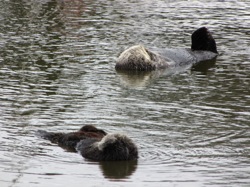This is the second in a series of posts on recent developments at the Monterey Bay Aquarium and its sister research institute.

An important source of funding for California Sea Otter research may be in jeopardy.
Since 2007, the California Sea Otter Fund has been one of several options for which state taxpayers could earmark money on their returns. That option may disappear. In order to maintain its slot on state tax forms, annual contributions need to attain a threshold set by the Franchise Tax Board. Lately, those donations have fallen about 25% short of the mark, currently set at more than $258,000. “It’s got to be the economy,” said Jim Curland, when I asked him if he could account for the lag. Curland works on marine programs for the non-profit Defenders of Wildlife, an organization that works closely with scientists investigating recent declines in the number of sea otters along the California coast. The otter fund competes with about a dozen other programs seeking donations on state tax forms.

The Monterey Bay Aquarium spends about a million dollars per year on sea otter research, according to spokesman Ken Peterson, who notes that female otters in particular, have been in decline. Scientists are trying to fund tagging and tracking programs to better understand changes in sea otter populations. “Any money out there that helps get answers is critical to their survival,” he told me. The California sea otter is listed as “threatened” under the federal Endangered Species Act and has “fully protected” status under the California Fish & Game Code.
Curland says proceeds from the tax form donations are split between the state’s Department of Fish & Game and the Coastal Conservancy, which has helped fund a key study off of Big Sur.
If you’re looking for the climate connection here, don’t strain for it. I’ll confess to just being a sucker for the cause. But there may be one. Wildlife biologists at the US Geological Survey (USGS) and UC Santa Cruz, have postulated that as custodians of giant kelp forests, the otters may help optimize carbon sequestration.
Curland says the next three months will be crucial for the fund, as donations trickle in from late filers.
